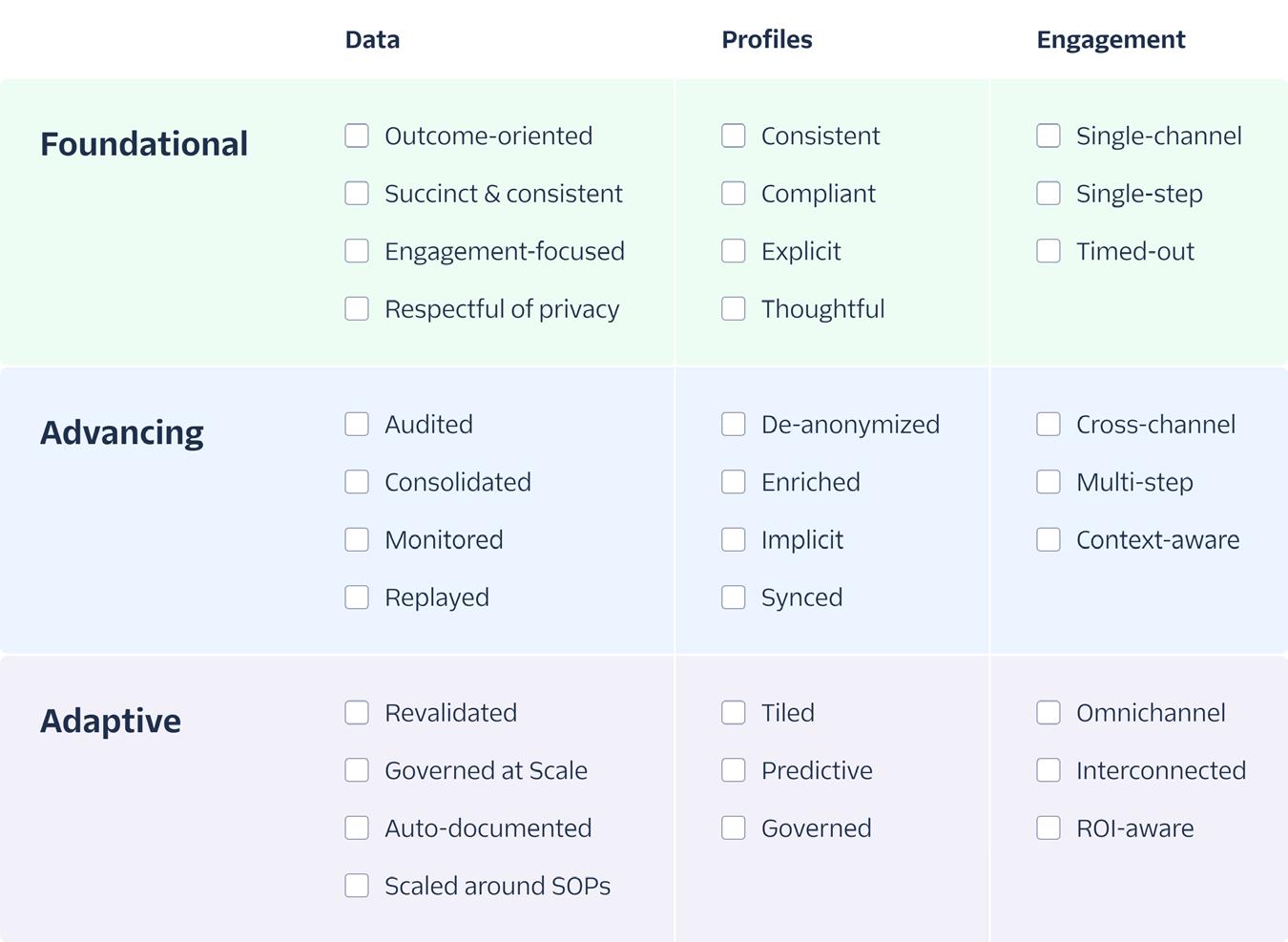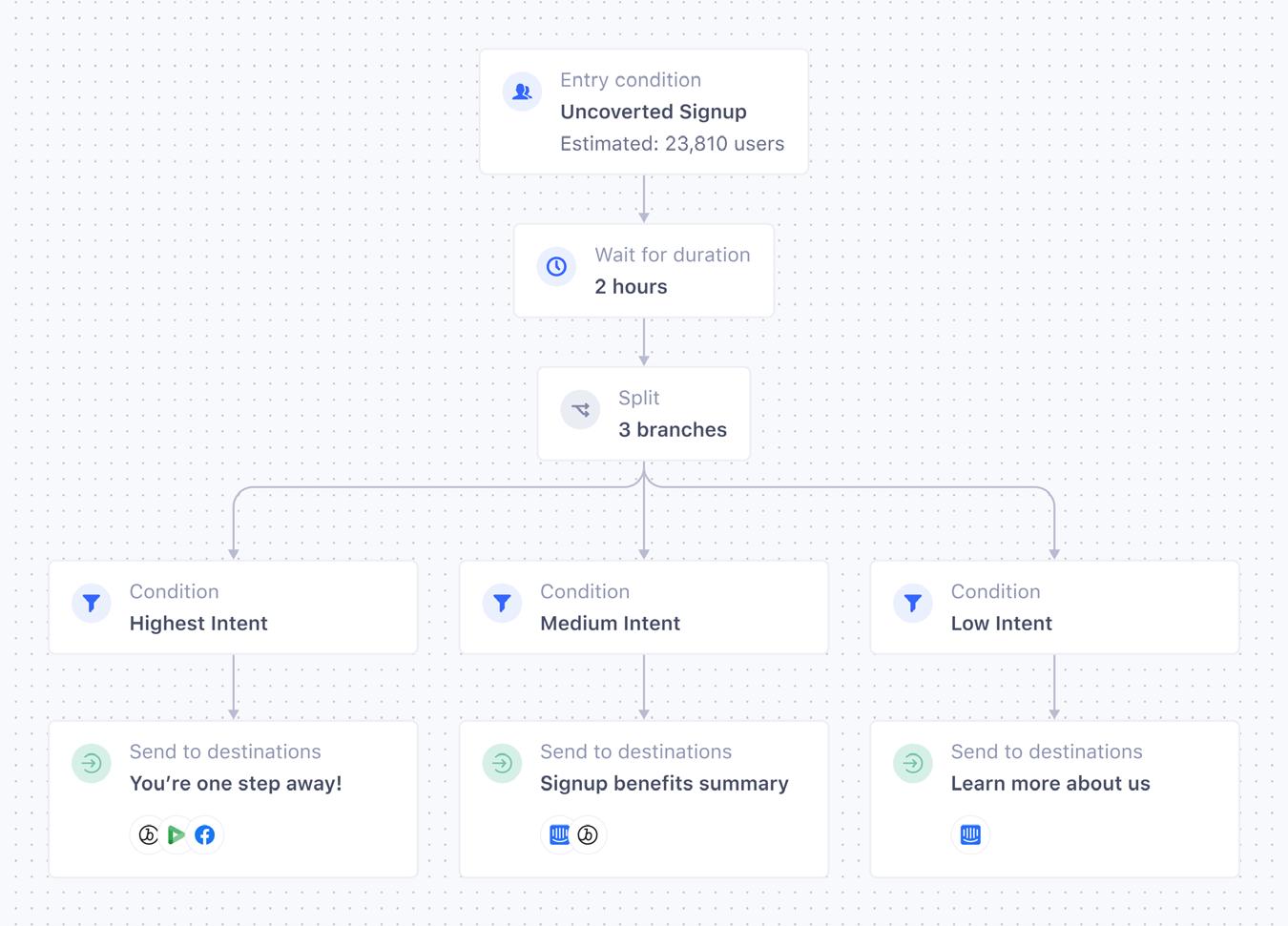
7 minute read
Foundational Profiles
LEVEL 01
Foundational
Advertisement
Collect data reliably around unified profiles and act on it to realize business value
Engagement
Data
Profiles
Single Channel
Single Step
Timed Out
Aligned Identifiers
Compliant Audiences
Explicit Preferences
Thoughtful Spaces
Outcome-Oriented
Succinct & Consistent
Focused on Engagement
Respectful of Privacy
Profiles unify your diverse data sources into a single view of each customer. In this section, we’ll be discussing some of the critical steps you need to take to ensure that your profiles are generated and maintained successfully, so you can easily build foundational engagement.
Aligned identifiers
A major requirement for building accurate customer profiles is identity resolution: merging all of a customer's interactions across every channel and touchpoint to create a unified profile. This can seem challenging when your customers don’t get identified the same way across each of your touchpoints. For example, the same person can anonymously visit your website, sign up for a newsletter, visit links from that newsletter on their mobile device, sign up for your app or service, populate their profile with additional contact information, and then call into your call center for help with a particular issue. How do you ensure that all of these activities are unified onto the same profile?
Segment’s approach to identity resolution enables you to provide many identifiers for the same person (such as user_id , email , phone , device_id , anonymous_id ), and then set the priority of matching to control how profiles are stitched together. It’s a powerful model which has helped our customers stitch billions of events together into unified profiles. But this model requires alignment and consistency in the way you stamp values for each identifier onto your events. Otherwise identity resolution won’t work.
Let’s say that two of your identifiers are phone number and email address. First, a user shows up on your website and registers with their email and phone number. The email is formatted in all lowercase, like name@domain.com , and the phone number is formatted as +1-123-456-7890 . Then, the user calls your call center, and their phone number is formatted as 1 (123) 456-7890 . Sadly, the events from the call center will NOT get stamped onto the same profile which was generated from the website events, because the phone numbers don’t exactly match. The same problem will occur if the call center agent types in the caller’s email as Name@Domain.com . The mixed case email isn’t an exact match with the lowercase email provided on the website, so the events from the call center won’t appear on the same profile as the events captured on the website.
This approach to identity resolution is called “deterministic” because it requires exact matches (instead of “fuzzy” or “probabilistic” matches) on identifier values to unify events into a single profile. While Segment’s deterministic identity resolution might seem overly rigorous, it’s actually highly beneficial. It enables 100% reliable profile unification, and it honors the exact first-party data a user provides to you, so your rationale for merging profiles (or keeping them separate) is completely transparent.
B2B Consideration: Group-Level Identifiers
If you’re leveraging CDP for B2B use cases, you’ll want to make sure your identity resolution strategy also incorporates the grouping of user profiles into accounts or other entities that align with your business structure. Within Twilio Segment, you can use the Group Call to establish attributes (or traits) of group profiles, as well as many-to-many relationships between group and user profiles. You can also automatically associate user behavior with a specific group id by providing a new or existing group identifier inside the context.group_Id element of any track call.
These relationships and behavioral associations enable the creation of account-level audiences, which are especially useful for B2B audience building and targeting efforts. When building account-level audiences, you’ll ultimately be able to surface a set of user profiles associated with both user-level and account-level criteria.
Compliant audiences
Unified profiles give you the ability to build highly-targeted Audiences based on criteria including events the user has (or hasn’t) performed across touchpoints, computations on top of those events
(like average_order_value ), and profile attributes like geographic region. But to stay compliant with privacy laws and policies, if you’re sending an audience to an advertising or marketing platform, you must be sure to exclude from that audience anyone who says they don’t want to be contacted for advertising or marketing purposes.
This exclusion does not happen automatically in Segment, since we focus on giving our customers the tools to enforce their interpretation of privacy laws and policies, rather than apply any interpretation on their behalf. This logic extends to our GDPR Deletion and Suppression endpoints (which enable you to remove and suppress further measurement of users with a user_id who have invoked their right to be forgotten), as well as our Privacy Portal, which enables you to obfuscate or eliminate specific event fields with sensitive information from being sent out of Segment.
These tools collectively enable you to operationalize many aspects of your compliance requirements related to laws such as GDPR and CCPA, but the requirements themselves must be decided by you and your legal team. Once in place, those policies can help you craft rules for compliant audience-building, which you should be sure to share with anyone building audiences in Engage before they send those audiences to downstream tools.
Explicit preferences
Foundational profiles can be rich with useful information, even if you’re collecting only a few additional profile attributes (called “traits” in Segment). And you don’t need to do complex computations to turn that data into preferences to personalize user engagement. You can just explicitly ask your users for pieces of information, and then use what they say to tailor messages.
For example, let’s say that as part of your app’s registration process, you ask users for their birthday and favorite color. Those are explicit preferences you can store on their Engage profile, and then use to send them relevant messages like a “treat yourself for your upcoming birthday” email two weeks before their birthday, or an inapp message or modal showing the hottest products on your site that match the user’s favorite color. The approach is surprisingly simple and also powerful. All that’s required is thoughtfulness around the profile attributes you collect, and alignment between those profiles and creative approaches to engagement.
Customer Insight
Industry: Customer Goods & Services
Founded in 1946, Fender's worldwide guitars, amps, pedals, and accessories have been played on more stages than any other company in the industry. With more than 75 years in the business, the Southern California company has established a worldwide influence that extends from the studio to the stage to the at-home consumer.
In 2017, Fender launched their subscription-based offering called Fender Play® – the complete learning app for guitar, bass, and ukulele.
The learn-as-you-go app is available as a monthly or annual subscription for iOS and Android users. With step-by-step guidance, students can study at their own pace while the app tracks their progress. Each bite-size session gradually increases in difficulty, upping a student’s skill level while offering a rewarding experience.
To increase adoption and retention rates, Fender collects data using Twilio Segment to streamline and optimize the onboarding process. Using data collected via Segment, several customer friction points were identified. Leaning into this knowledge, they removed unnecessary steps in the sign-up process, driving a 5% increase in active paying users.
To further optimize onboarding they looked at their data collection screens and asked themselves if asking users about the instrument or type of music they wanted to play was necessary. To their surprise, most people didn’t skip that step, so they kept those data fields in and cut screens users interacted with less.
By analyzing the data, Fender found that when users set their intention upfront, identifying their ability level and the instrument and genre they’re most interested in, they were intrinsically setting themselves up for success. Users were choosing to engage in an activity they enjoyed (and would get personal satisfaction from) which made them more likely to continue practicing. Further, providing gentle nudges when needed or kudos when a milestone is reached has contributed to reduced churn by 29%.
Read the full case study >

Thoughtful spaces
When getting started with Segment, we strongly encourage our customers to be thoughtful about how they’re setting up their tracking environments. Specifically, we recommend that you isolate your dev, staging, and prod environments to keep your prod data as “clean” as possible. Otherwise, you’ll need to “untangle” your dev and prod data in downstream tools such as analytics platforms.

For example, if you simultaneously point a staging website and a live production website to a single Segment source, and then into a single downstream destination, the destination will contain all of the traffic from your test users and your actual users. This will throw off your calculation of key metrics like Daily Active Users, total orders completed, revenue generated, and retention. The prod data gets “polluted” with test and development data, and becomes untrustworthy to your stakeholders.
The same principle applies to Engage Spaces – which contain the identity resolution rules for a specific set of sources connected together to form unified profiles. If you combine your dev, staging, and production data together into a single space, you’ll mix actual user profiles with ones generated for development, testing, and QA purposes. This in turn will throw off your audience counts and may even cause good profiles to inadvertently merge with bad ones (once you merge a profile based on identifiers and identity rules you've established, you cannot undo that merge). That mixing and potential merging, in turn, causes distrust in the profile data, and reluctance from the marketing or product teams to activate those profiles with engagement.
For those reasons, we strongly encourage you to split your Spaces just like you’d split your sources. Doing so will give you well-defined boundaries between sometimes messy engineering and QA work and precious production data. If you’re looking for an easy way to classify your sources and spaces (and also manage access around that classification), check out Labels in Segment.





